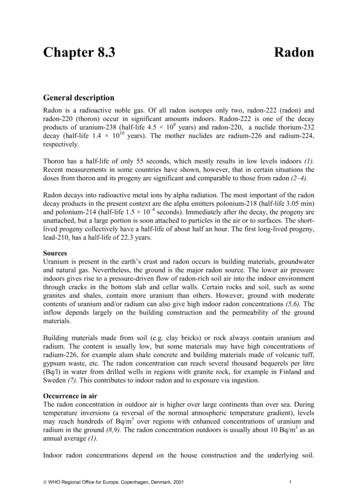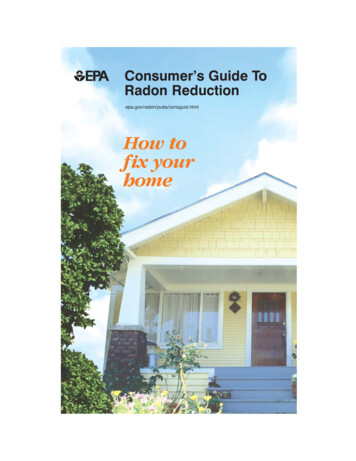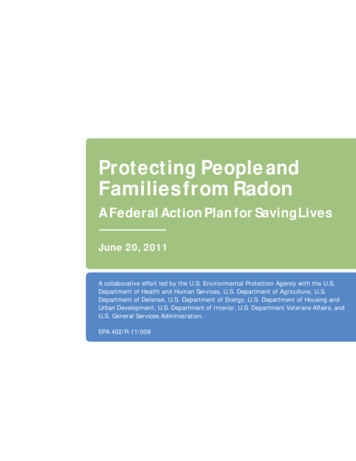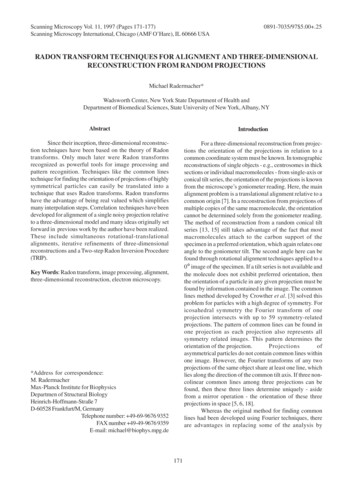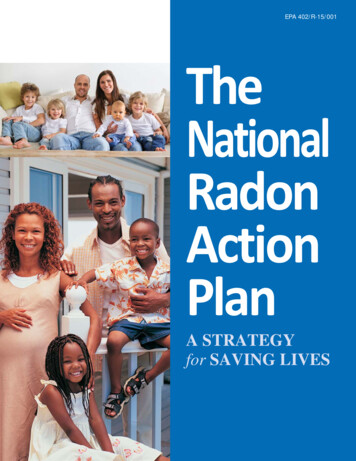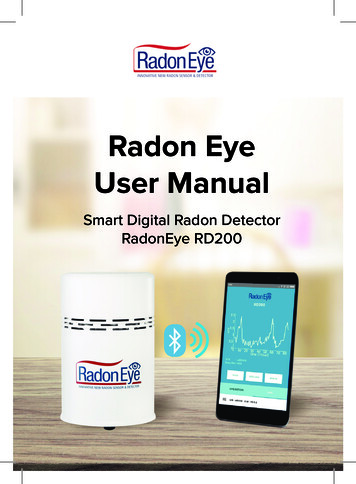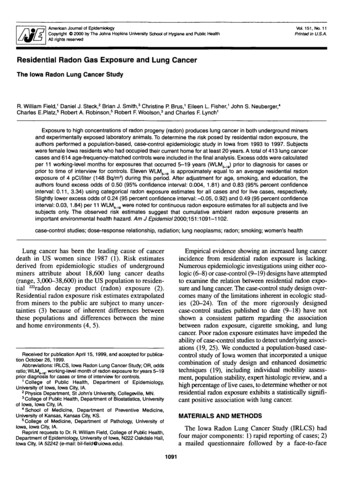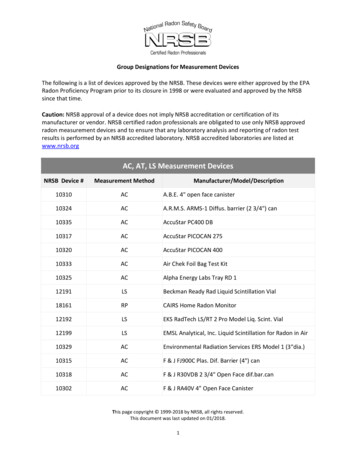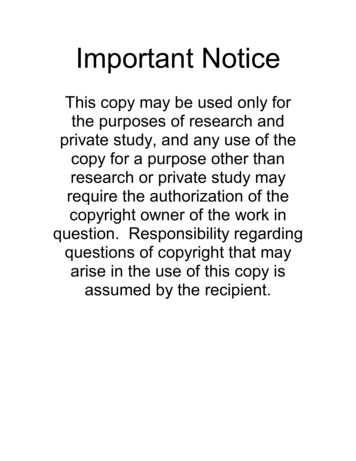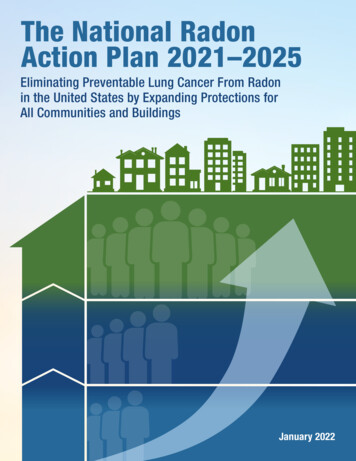
Transcription
SECTION ONERADON1. Is the presence of radon a material fact in North Carolina?2. Which of the following provide(s) reliable evidence of an elevated radon level?(Select all that apply.)a. Presence of stone on the propertyb. Topography and soil compositionc. Strong odor that is unique to radond. Proximity to another home with an elevated radon levele. Radon test performed by a home inspector or radon inspector or homeowner3. You are representing a buyer who is moving to North Carolina from another state.Your buyer asks that a radon test be performed as part of the home inspection.According to the test results, the home has a radon level of 4.2 pico curies per liter[hereinafter “pCi/L”]. What are your buyer’s options?4. You are acting as a dual agent in a transaction. During the due diligence phase, theradon test reveals a radon level of 3.2 pCi/L, and the buyer decides to terminate thecontract as a result. Are you required to disclose the radon test result to all futurebuyers?5. If a seller knows that the house has been tested for radon and the test revealed thatthe house has a level equal to or exceeding 4.0 pCi/L, must the seller disclose thefact to prospective buyers?Learning ObjectivesUpon completing this Section, you should be able to: describe radon and its risks;explain when the presence of radon OR a radon mitigation system is a material fact; andexplain how a high level of radon may be corrected.Page 1
What is Radon?Radon is a naturally occurring colorless, odorless, radioactive gas found in most soils and rock. It iscaused by the normal decomposition of uranium, releasing radium atoms that emit alpha particles intothe air we breathe. It is everywhere; no state is exempt. Outdoors, the concentration is so nominal thatits impact on human health is negligible. However, in confined quarters, high levels of radon can beproblematic. When we breathe, we inhale the radioactive alpha particles that can then lodge in ourlungs.How Dangerous is Radon?Radon is the number one cause of lung cancer among non-smokers in the United States, according toEnvironmental Protection Agency (EPA) estimates. Overall, radon is the second leading cause of lungcancer. Radon is responsible for about 21,000 lung cancer deaths nationally every year. About 2,900 ofthese deaths occur among people who have never smoked. (Read more athttps://www.epa.gov/radon/health-risk-radon.)The table below indicates the risk of lung cancer from radon compared to the likelihood of death fromother causes for people who have never smoked versus those who are or were smokers. Theinformation presented merges two separate tables that may be found on the EPA’s website and in theHome Buyer’s and Seller’s Guide to Radon, p. 18. [EPA 402/K-13/002, September 2013 (revised).]Radon Risk for Non-Smokers and Current/Former SmokersRadonLevelIf 1,000 people who neversmoked were exposed to thislevel over a lifetime*If 1,000 people whosmoked were exposed tothis level over a lifetime*20pCi/LAbout 36 people couldget lung cancerAbout 260 people couldget lung cancer10pCi/LAbout 18 people couldget lung cancerAbout 150 people couldget lung cancer8pCi/LAbout 15 people couldget lung cancerAbout 120 people couldget lung cancer4pCi/LAbout 7 people couldget lung cancerAbout 62 people couldget lung cancer2pCi/LAbout 4 people couldget lung cancerAbout 32 people couldget lung cancer1.3pCi/L0.4pCi/LAbout 2 people couldget lung cancerAbout 20 people couldget lung cancerAbout 3 people could get lungcancerThe risk of cancer fromradon exposure compares to**Nonsmoker: 35 times risk ofdrowningSmoker: 250 times risk ofdrowningNonsmoker: 20 times risk ofdying in a home fireSmoker: 200 times the risk ofdying in a home fireNonsmoker: 4 times the risk ofdying in a fallSmoker: 30 times the risk ofdying in a fallNonsmoker: The risk of dying ina car crashSmoker: 5 times the risk ofdying in a car crashNonsmoker: The risk of dyingfrom poisonSmoker: 6 times the risk ofdying from poison(Average indoor radon level.)(Average outdoor radon level.)* Lifetime risk of lung cancer deaths from EPA Assessment of Risks from Radon in Homes .** Comparison data calculated using the Centers for Disease Control and Prevention's 1999-2001National Center for Injury Prevention and Control Reports.Page 2
Estimated Lung Cancer Deaths per YearRadon is recognized as a known lung carcinogen by the: Environmental Protection Agency (EPA),World Health Organization (WHO),National Academy of Sciences (NAS),Center for Disease Control (CDC), andUS Department of Health and Human Services (DHHS).The comparison graph below may be found on the EPA’s website.*Radon is estimated to cause about 21,000 lung cancer deaths per year, according to EPA’s 2003Assessment of Risks from Radon in Homes (EPA 402-R-03-003). The numbers of deaths from othercauses are taken from the Centers for Disease Control and Prevention’s 2005-2006 National Center forInjury Prevention and Control Report and 2006 National Safety Council Reports.Courtesy of /documents/hmbuygud.pdf.Page 3
This exercise is based on “Radon Myths and Facts,” from the brochure, HomeBuyer’s and Seller’s Guide to Radon, pages 27-28. [Publication: EPA 402/K13/002, revised September 2013, available on the EPA’s website.]1.2.3.4.5.6.True or False? Radon testing devices are not reliable and are difficult to find.True or False? Radon testing is difficult and time-consuming.True or False? Homes with high radon levels can be fixed.True or False? Radon only affects certain types of homes.True or False? Radon is only a problem in certain parts of North Carolina.True or False? A neighbor’s test result is a good indication of whether yourhome has a radon problem.7. True or False? Everyone should test their water for radon.8. True or False? I have lived in my home for so long it does not make sense totake action now.9. True or False? Short term tests can be used to make a decision about whether toreduce the home’s high radon levels.EPA Recommended Action Level: 4.0 pCi/LTo reduce the risk of lung cancer, the EPA has set a recommended "action level" for homes with radonlevels of 4.0 pCi/L of air or higher.What is a "picocurie" (pCi)?A pCi is a measure of the rate of radioactive decay of radon. One pCi is one trillionth of aCurie, 0.037 disintegrations per second, or 2.22 disintegrations per minute.Therefore, at 4.0 pCi/L, there will be approximately 12,672 radioactive disintegrations in oneliter of air during a 24-hour period. (Courtesy of https://sosradon.org/Radon%20Basics.)The EPA strongly urges mitigation if interior readings equal or exceed 4.0 pCi/L and furtherrecommends reduction measures if radon readings are between 2.0-4.0 pCi/L.Nationally: 1 in 15 homes are estimated to be at or above 4.0 pCi/L.Per the EPA’s Report on the Environment (https://cfpub.epa.gov/roe/):The number of American homes at or above 4.0 pCi/L was estimated by applying the results ofthe Radon Survey (U.S. EPA, 1992a) to 2000 U.S. Census data on the number of U.S.households. The 1992 National Residential Radon Survey was based on the housing stock thatwould be covered by EPA's radon testing policy (i.e., homes that should test). This includedonly homes intended for regular (year-round) use and covers single-family homes, mobilehomes on permanent foundations, and multi-unit and group quarters (U.S. EPA, 1992b).The 1992 residential survey estimated that about one in 15 homes in EPA's "should test"category would have a radon level of 4.0 pCi/L or more. The measure of the number of homesPage 4
with operating mitigation systems was developed from radon vent fan sales data providedvoluntarily by fan manufacturers (U.S. EPA, 2014).Are Radon Levels High in North Carolina?YES. North Carolina is one of 28 states classified by the EPA as having “exceptionally high” levels ofradon, i.e., at or above 4.0 pCi/L. The map below is colored/shaded according to the legend below toreflect the radon levels by North Carolina county.NC Radon MapCourtesy of http://www.ncradon.org/ncradon/#.Page 5
In North Carolina, a Radon Level Equal To or Exceeding 4.0 pCi/L is aMaterial FactDisclosure by Owner/Seller: Residential Property and Owners AssociationDisclosure StatementIn North Carolina, the Residential Property and Owners Association Disclosure Statement(RPOADS) is a disclosure form that most owners selling residential property in North Carolinamust complete and provide to prospective buyers.Question 25 on the RPOADS asks:Are there any hazardous or toxic substances, materials, or products (such asasbestos, formaldehyde, radon gas, methane gas, lead-based paint) whichexceed government safety standards, any debris (whether buried or covered)or underground storage tanks, or any environmentally hazardous conditions(such as contaminated soil or water, or other environmental contamination)which affect the property?As with all questions on the RPOADS, the seller may answer:Yes, indicating the seller has knowledge of a problem;No, indicating the seller has no actual knowledge of any problem; orNo Representation, indicating the seller chooses not to disclose the conditionsor characteristics of the property, even if the seller has actual knowledge ofthem or should have known of them.Disclosure by BrokerOf course, a broker is always required to disclose material facts, regardless of how a sellerchooses to complete the RPOADS. Consequently, if a broker knows – or reasonably shouldhave known – that a property’s radon level meets or exceeds 4.0 pCi/L, the broker mustdisclose that fact to all clients and third parties to the transaction.NOTE: Broker disclosure requirements apply in sales AND lease transactions. Thus, if abroker engaging in property management knows – or reasonably should have known – that aproperty’s radon level meets or exceeds 4.0 pCi/L, the broker must disclose that fact to alltenants and prospective tenants.Page 6
1. How would a broker know that a property’s radon level meets or exceeds 4.0 pCi/L?2. If a broker knows that a property’s radon level meets or exceeds 4.0 pCi/L, howmight the broker disclose the information to clients and customers?3. Should brokers recommend that buyers have radon tests performed? Why or whynot?How is Radon Detected?Measurement Tools: Passive & Active DetectorsTesting devices may be either passive, needing no power to function, or active, requiring powerto operate. Passive devices include charcoal canisters, alpha-track detectors, charcoal liquidscintillation devices, and electret ion detectors. Active radon detectors include continuous radon monitors (CRM) and continuous workinglevel monitors. Active devices provide the most complete information as they:1)2)3)4)record radon levels at various time intervals;track variations in radon concentrations;may reveal tampering; andprovide results on-site.An active detector is a more expensive test, requires power to operate, and must be regularlyand properly calibrated. Passive devices, whether short-term or long-term test kits, may bepurchased fairly inexpensively at various home supply or hardware stores or ordered on the NCRadon Program’s website at http://ncradon.org/Purchase a kit.html. The NC Radon Program isan outreach effort of the NC Radiation Protection Section within the Department of Health andHuman Services. The Radon Program is involved in public information, residential, and schoolmonitoring projects, and provides technical advisory services to other State and countyagencies involved with radon gas.Page 7
Who Performs Radon Testing?Individuals may purchase “do-it-yourself” test kits, follow the directions regarding how toperform the tests, and then mail or deliver kits to the indicated address for analysis.Alternatively, a certified professional may be hired to conduct the test or a prospective buyer’shome inspector might conduct a radon test as part of the home inspection, even though thehome inspector may not be certified as a radon tester.Few states regulate, license, or even require registration by radon testers or mitigators with anysupervisory agency. However there are three (3) independent organizations that issue radontesting and mitigation certifications to individuals who successfully complete the prescribedcourse of study. These independent organizations are the:1) National Radon Safety Board (NRSB);2) National Radon Proficiency Program (NRPP), and3) Inspector Nation.There is no North Carolina regulatory agency that oversees radon testing or mitigation, nordoes North Carolina require individuals to be certified, although consumers are advised to hirecertified individuals.How Long Will a Radon Test Take?Per the EPA’s Home Buyer’s and Seller’s Guide to Radon:“Whether you test for radon yourself or hire a qualified tester, all radon tests should betaken for a minimum of 48 hours. Some devices require a longer (minimum) length oftime, e.g., a 7-day charcoal canister device.”Proper Use of Test DevicesPer the EPA’s Home Buyer’s and Seller’s Guide to Radon:“When you are taking a short-term test, close windows and doors to the outside andkeep them closed, except for normal entry and exit.If you are taking a short-term test lasting less than four days, be sure to: Close your windows and outside doors at least 12 hours before beginning thetest; Do not conduct short-term tests lasting less than four days during severe stormsor periods of high winds; Follow the testing instructions and record the start time and date; Place the test device at least 20 inches above the floor in a location where it willnot be disturbed and where it will be away from drafts, high heat, high humidity,and exterior walls; Leave the test kit in place for as long as the test instructions say; and Once the test is finished, record the stop time and date, reseal the package, andreturn it immediately to the lab specified on the package for analysis.”Page 8
How is a High Level of Radon Corrected?The installation of a radon mitigation/reduction system should significantly reduce the radon level ina home. The purpose of radon reduction or mitigation systems is to vent air emitted from the soilsunder the dwelling around or through the dwelling for release outside the structure.While the methods may differ, the theme is the same: a pipe is installed running from under thedwelling’s foundation up through the dwelling and vents the air to the outside.Systems include: Exterior installed system: visible from the outside of the home and subject to freeze and thawcycles of weather. Attic installed system: a pipe may be installed in the garage and routed through the atticabove, or if the garage option isn’t available, the pipe may be installed and run through closetsor utility chases to the attic. Passive mitigation system: common design is a four inch gas permeable gravel layer under aconcrete slab with a soil gas collection pipe buried in the gravel that connects to a suction pipeextending through the interior of the dwelling and ultimately vents out the roof through anexhaust point. Active mitigation system: similar in design to a passive system, but has a motor or fan thatcreates suction to pull more radon out of the soil.In recent years, more builders have begun routinely installing passive mitigation systems at the timethey construct the dwelling, as it is far less expensive to install a system during construction, than toadd one later. If the passive system is not adequate to keep radon levels in the home around 2.0 pCi/L,a fan can be installed later to convert the passive system into an active system. Fans often have awarranty and must be checked periodically to ensure the system is still operating as intended.Builders who want to earn a “green built” certification for their properties often include radon resistantfeatures during construction. The excerpt below, “Common Features in Radon Resistant Buildings,” isreprinted from the EPA’s booklet, Home Buyer’s and Seller’s Guide to Radon (page 10) and identifiescommon radon resistant additions.Page 9
Common Features in Radon Resistant Buildings1. Gas‑Permeable Layer: This layer is placed beneath the slab or flooring system to allowthe soil gas to move freely underneath the house. In many cases, the material used is a 4inch layer of clean gravel. This gas-permeable layer is used only in homes with basementand slab-on-grade foundations; it is not used in homes with crawlspace foundations.2. Plastic Sheeting: Plastic sheeting is placed on top of the gas-permeable layer and underthe slab to help prevent the soil gas from entering the home. In crawl spaces, the sheeting(with seams sealed) is placed directly over the crawlspace floor.3. Sealing and Caulking: All below-grade openings in the foundation and walls are sealedto reduce soil gas entry into the home.4. Vent Pipe: A 3-4 inch PVC pipe (or other gas-tight pipe) runs from the gaspermeable layer through the house to the roof to safelyvent radon and other soil gases to the outside.5. Junction Boxes: An electrical junction box is included in theattic to make the wiring and installation of a vent faneasier. For example, you decide to activate the passivesystem because your test result showed an elevated radonlevel (4.0 pCi/L or more). A separate junction box is placedin the living space to power the vent fan alarm. An alarm isinstalled along with the vent fan to indicate when the vent fanis not operating properly.Must a broker disclose that a home has a radon reduction/mitigation system?The 2008-2009 Real Estate Update course had a section titled “Material Facts.” When discussingradon, the section offered the following guidance:What if the seller had a radon problem in the past but installed some radonreduction system to remediate the problem and bring the radon within acceptableEPA levels. Is the mere presence of the radon reduction system a material fact?Because it was installed to remedy an existing problem which could reoccur if thesystem failed to operate correctly, the presence of the system should be viewed as amaterial fact and disclosed to prospective purchasers.In other words, the presence of the system was a material fact because it existed to redress a knownproblem.In past years, the presence of a radon mitigation system seemed to imply a problem, as it was notcommon practice to routinely include such features when building a structure. However, as notedpreviously, more and more builders are installing passive systems and implementing many of thePage 10
EPA’s radon resistant practices as standard features of construction. Thus, the Commission decided toreconsider the material fact issue in light of changing practices.Following presentations by staff from the NC Radiation Protection Section of the NC Department ofHealth and Human Services and extended discussions over several months regarding changingresidential building practices, the Commission decided that the mere presence alone of a radonreduction/mitigation system is not a material fact.However, a broker should investigate further when such a system is noticeable. For example, a brokershould ask the seller whether the system contains a fan or motor, whether it is functioning, whether thehome was tested and, if so, whether the results are known or the test report is available, and whetherthe system was installed when the house was built or after-market. Disclosure may be necessarydepending on the answers to these types of questions about the system. Commission staff alwaysencourages full and timely disclosure so a buyer can make a fully-informed decision before becomingbound by a contract. The Commission will evaluate situations based on individual facts.Page 11
ANSWERS TO DISCUSSION QUESTIONSPage 1 Scenarios1. Is the presence of radon a material fact in North Carolina?Answer: Yes, if the radon level is 4.0 pCi/L or higher. If radon is present but measures less than4.0 pCi/L, it is not a material fact.2. Which of the following provide(s) reliable evidence of an elevated radon level? (Select all thatapply.)a. Presence of stone on the propertyb. Topography and soil compositionc. Strong odor that is unique to radond. Proximity to another home with an elevated radon levele. Radon test performed by a home inspector or radon inspector or homeownerAnswer: E.3. You are representing a buyer who is moving to North Carolina from another state. Your buyerasks that a radon test be performed as part of the home inspection. According to the test results,the home has a radon level of 4.2 pico curies per liter [hereinafter “pCi/L”]. What are yourbuyer’s options?Answer: The buyer’s options include:A) terminating the contract;B) asking the seller to remediate prior to closing;C) requesting a reduction in the purchase price to cover buyer’s installation of a radon mitigationsystem, if the seller refuses to remediate;D) accepting the property with its existing levels and mitigate the radon level after closing.4. You are acting as a dual agent in a transaction. During the due diligence phase, the radon testreveals a radon level of 3.2 pCi/L, and the buyer decides to terminate the contract as a result. Areyou required to disclose the radon test result to all future buyers?Answer: No. The presence of radon is a material fact only when the level is equal to or exceeds 4.0pCi/L. Brokers are not required to disclose radon levels less than 4.0 pCi/L.5. If a seller knows that the house has been tested for radon and the test revealed that the house has alevel equal to or exceeding 4.0 pCi/L, must the seller disclose the fact to prospective buyers?Answer: No. North Carolina is a caveat emptor state (“let the buyer beware”) and, as discussedearlier, most owners must provide the RPOADS, but they aren’t required to disclose anyinformation due to the “no representation” option. Only real estate brokers are required todiscover and disclose material facts, and they may be disciplined for the negligent or willful failureto disclose a material fact.Page 12
Page 4 Radon True / False ExerciseThis exercise is based on “Radon Myths and Facts,” below from the brochure, Home Buyer’s andSeller’s Guide to Radon, pages 27-28. [Publication: EPA 402/K-13/002, revised September 2013,available on the EPA’s website.]1. Radon testing devices are not reliable and are difficult to find.FALSE: Reliable radon tests are available from qualified radon testers and companies. Activeradon devices can continuously gather and periodically record radon levels to reveal any unusualswings in the radon level during the test. Reliable testing devices are also available by phone or mailorder, and can be purchased in hardware stores and other retail outlets. Contact your state radon officefor a list of qualified radon test companies.Note: It is important to carefully follow testing instructions. If a broker or homeowner tampers with atesting device or opens windows during the test, the results may be inaccurate.2. Radon testing is difficult and time-consuming.FALSE: Radon testing is easy. You can test your home yourself or hire a qualified radon test company.Either approach takes only a small amount of time and effort.3. Homes with high radon levels can be fixed.TRUE: High radon levels may be significantly reduced by the installation of a radon mitigation system.4. Radon only affects certain types of homes.FALSE: Radon can be a problem in all types of homes, including old homes, new homes, drafty homes,insulated homes, homes with basements, and homes without basements. Local geology, constructionmaterials, and how the home was built are among the factors that can affect radon levels in homes.5. Radon is only a problem in certain parts of the state.FALSE: High radon levels have been found in every part of the state. Radon problems do vary fromarea to area, but the only way to know a home’s radon level is to test.6. A neighbor’s test result is a good indication of whether your home has a radon problem.FALSE: Radon levels vary from home to home. The only way to know if your home has a radon problemis to test it.Note that if your home is an attached dwelling such as a townhome or condominium unit, and yourneighbor’s home has a high radon level, it is very likely that your home, too, will have a high level.7. Everyone should test their water for radon.FALSE: While radon gets into some homes through the water, it is important to first test the air in thehome for radon. If your water comes from a public water system that uses ground water, call your watersupplier. If high radon levels are found and the home has a private well, call the Safe Drinking WaterHotline at (800) 426-4791 for information on testing your water. Also, call your state radon office formore information about radon in air.Page 13
8. I have lived in my home for so long, it does not make sense to take action now.FALSE: You will reduce your risk of lung cancer when you reduce radon levels, even if you have livedwith an elevated radon level for a long time.9. Short-term tests can be used for making a decision about whether to reduce the home’s high radonlevels.TRUE: Short-term tests can be used to decide whether to reduce the home’s high radon levels.However, the closer the short-term testing result is to 4.0 pCi/L, the less certainty there is as to whetherthe home’s year-round average is above or below that level. Keep in mind that radon levels below 4.0pCi/L still pose some risk and that radon levels can be reduced to 2 pCi/L or below in most homes.Page 7 Discussion Questions1. How would a broker know that a property’s radon level meets or exceeds 4.0 pCi/L?Answer: Seller or previous prospective buyer had a radon test conducted on the property.2. If a broker knows that a property’s radon level meets or exceeds 4.0 pCi/L, how might the brokerdisclose the information to clients and customers?Possible answers include: MLS, emails, property information sheets, etc.3. Should brokers recommend that buyers have radon tests performed? Why or why not?Answer: As a best practice, brokers should recommend that every residential buyer have a radontest performed. Further, brokers should inform clients/customers of radon’s prevalence in NorthCarolina.Page 14
Safe at Home: Preventing Lung CancerBY REDUCING RADON IN THE HOMEWhy should I beconcerned about radon?What is radon? Radon isa gas that you cannot see, smellor taste. It comes from the decayof radioactive elements (such asuranium, thorium and radium) in soiland groundwater.Breathing in radon is the secondleading cause of lung cancer aftersmoking. Radon is the likely causeof more than 21,000 lung cancer deathseach year in the U.S. In 2015, lung cancer wasthe leading cause of cancer deaths in N.C.What are your chances forgetting lung cancer fromradon? Each one of the followingHow does radon cause lungcancer? Radon gas decays intoinfluences your risk:1.Level of radon in your home;2.The amount of time youspend in your home;3.If you are a smoker of tobaccoor have ever smoked tobacco;and4.If you are exposed to secondhandsmoke.radioactive particles that can gettrapped in your lungs when youbreathe. These particles break downand release small bursts of energy.This can damage lung tissue andlead to lung cancer over the course ofyour lifetime. Not everyone exposed tohigh levels of radon will develop lung cancer,however the risk for lung cancer is increased.How does radon get into ahome? Radon can rise from theWhere is radon found in N.C.?Nearly one out of every 15 homes inthe U.S. is likely to have a high levelof radon. Homes in all 100 countiesof N.C. have tested at high levelsfor radon. The only way to know ifyour home has a radon problem isto test it. (continued )rocks in the ground, through thesoil, and to the air above. It comesinto your home through cracksand holes in the foundation. Theradon becomes trapped in yourhome. This can happen in new andold homes, homes with or withoutbasements, and in high-rise andmulti-family buildings. Undergroundwell water can transport radon fromthe soil into the house.Page 15
Is radon only measuredin homes? No. Radon can getHow do I fix my homeif the test show thereis a high level of radonin water? The N.C Divisioninto any type of building. You andyour family are most likely to beexposed at home because youspend most of your time there.of Public Health recommendstesting well water for radon.Its experts say you should fixwell water that tests high forradon. If the radon level is highin the well water, a second testfor other types of radioactiveparticles like uranium andradium should be done. Selecta contractor who is trained tofix radon problems. Contactyour county health department’senvironmental health programfor more information.What is considered ahigh level of radon inthe home? The amount ofradon in the air is measured in“picocuries per liter of air,” or“pCi/L.” A radon level in thehome between 2 and 4 pCi/L isconsidered moderate risk andover 4 pCi/L is considered highrisk for your health.What will fixing myhome cost me? In 2017,I am buying/selling ahome. How do I get aproperty tested for radon?the average cost for fixing a radonproblem in an existing home was 1,500. The average cost to include aradon reduction system when buildinga new home was 800. The cost fora private well water radon treatmentsystem ranges between 1,500 - 5,000.Visit www.ncradon.org to learn more aboutbuilding Radon Resistant New Construction.There are no laws in N.C. regardingradon testing. The N.C. RadonProgram recommends that you hirea certified radon contractor. This willgive you reliable test results quickly. Ifyou get your water from a well, you can testyour groundwater for radon with a certifiedlaboratory. Visit www.ncradon.org to find acertified radon tester.Will a radon reduction systemimpact the sale of my home?What if the radon levels arehigh in my home? Can myhome be fixed? The EPA (U.S.Environmental Protection Agency)recommends fixi
e. Radon test performed by a home inspector or radon inspector or homeowner . 3. You are representing a buyer who is moving to North Carolina from another state. Your buyer asks that a radon test be performed as part of the home inspection. According to the test results, the home has a radon level of 4.2 pico curies per liter [hereinafter .
